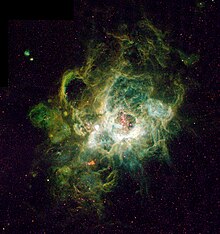NGC 604
| Emission nebula | |
|---|---|
| H II region | |

|
|
| Observation data: J2000 epoch | |
| Right ascension | 01h 34m 33.2s |
| Declination | +30° 47′ 06″ |
| Distance | 2,700,000 ly (840,000 pc) |
| Apparent magnitude (V) | +14.0 |
| Apparent dimensions (V) | 1′.93 x 1′.2 arcmins |
| Constellation | Triangulum |
| Physical characteristics | |
| Radius | 760 ly |
| Absolute magnitude (V) | -13.8 |
| Notable features | massive H II region |
NGC 604 is an H II region inside the Triangulum Galaxy. It was discovered by William Herschel on September 11, 1784. It is one of the largest H II regions in the Local Group of galaxies; at the galaxy's estimated distance of 2.7 million light-years its longest diameter is roughly 1500 light years (460 parsecs), over 40 times the size of the visible portion of the Orion Nebula. It is over 6300 times more luminous than the Orion Nebula, and if it were at the same distance it would outshine Venus. Its gas is ionized by a cluster of massive stars at its center. with 200 stars of spectral type O and WR, a mass of 105solar masses, and an age of 3.5 million years; however, unlike the Large Magellanic Cloud's Tarantula Nebula central cluster (R136), NGC 604's one is much less compact and more similar to a large stellar association, being considered the prototypical example of a Scaled OB Association (SOBA)
...
Wikipedia
